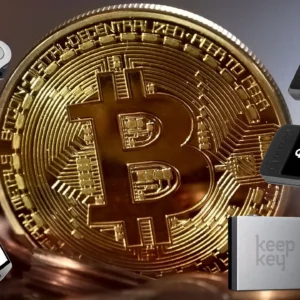The rise of digital assets has revolutionized the financial landscape, giving birth to a decentralized economy that’s open 24/7, borderless, and continuously evolving. As this revolution marches forward into 2025, one thing remains clear: security and accessibility are non-negotiables for every crypto investor.
Whether you’re holding Bitcoin, trading altcoins, or staking tokens, securing your assets against hacks, phishing attacks, and unauthorized access is critical. And that’s exactly where mobile crypto wallets with biometric security features — fingerprint and Face ID — become indispensable.
In this post, we’ll explore why these wallets are vital in 2025, compare the best options on the market, break down the technology behind biometric authentication, and help you understand how to stay both secure and convenient in the ever-evolving world of crypto.
Why Mobile Wallets Matter More Than Ever in 2025
The cryptocurrency space has matured immensely since Bitcoin’s inception. With over $3 trillion in market capitalization as of 2025, the stakes are higher than ever. And with rising adoption of DeFi, NFTs, DAOs, and blockchain-based identity systems, mobile access to crypto wallets has become not just a convenience but a necessity.
Here’s why mobile wallets are crucial:
- On-the-go accessibility: Traders and investors can buy, sell, swap, or send crypto in real-time, anywhere.
- DeFi access: Mobile wallets often integrate with Web3 platforms like Uniswap, Aave, and Compound.
- Speed and convenience: No more waiting for a desktop login or plugging in a hardware wallet.
- Multi-chain support: Access multiple blockchains from a single mobile interface.
But this mobile convenience introduces risk. If someone gets access to your phone, they potentially get access to your crypto. That’s why biometric security is no longer a luxury — it’s a must-have.
What is Biometric Security, and Why Is It Essential?
Biometric authentication uses unique biological characteristics — such as fingerprints or facial features — to verify identity. Unlike passwords or PINs that can be guessed, stolen, or phished, biometrics are:
- Unique: No two people have identical fingerprints or facial maps.
- Immutable: You can forget a password, but not your fingerprint.
- Difficult to hack: Especially with secure enclave-based storage on modern devices.
According to Forbes, biometric security drastically reduces the chances of unauthorized access and is being rapidly adopted across financial and healthcare sectors. In crypto, where there’s no central authority to reset your wallet, it’s even more vital.
Benefits of Using Mobile Crypto Wallets with Fingerprint or Face ID
Let’s break down the core benefits of using biometric security features in your crypto wallets:
1. Enhanced Security
Biometric data is stored in secure environments (like Apple’s Secure Enclave or Android’s Trusted Execution Environment), making it harder for malicious apps or third parties to access.
2. Protection Against Phishing and Keylogging
Unlike passwords or seed phrases, fingerprints can’t be phished through fake websites or keyloggers.
3. Faster Login and Transaction Approvals
Biometric login is instant. You don’t need to type complex passwords or remember PINs, reducing friction in your user experience.
4. Lost or Stolen Phone? You’re Still Protected
If someone gains physical access to your device, they still can’t unlock your wallet without your biometrics.
Top Mobile Crypto Wallets with Biometric Security in 2025
We reviewed dozens of mobile wallets and selected the best based on security features, ease of use, multi-chain compatibility, and biometric integration. Here’s a comparison table of the top contenders:
| Wallet Name | Biometric Support | Supported Chains | NFT Support | Security Rating | App Store Rating |
|---|---|---|---|---|---|
| Trust Wallet | Face ID, Fingerprint | Ethereum, BSC, Solana, +30 | Yes | High (Audit Verified) | 4.7 (iOS), 4.5 (Android) |
| MetaMask Mobile | Face ID, Fingerprint | Ethereum, BSC, Layer 2s | Yes | Medium-High | 4.6 (iOS), 4.4 (Android) |
| Coinbase Wallet | Face ID, Fingerprint | Ethereum, Polygon, Solana | Yes | Very High (Coinbase Security Infra) | 4.8 (iOS), 4.5 (Android) |
| SafePal Wallet | Fingerprint only | Multi-chain (including BTC) | Yes | High (Hardware Compatibility) | 4.5 (iOS), 4.4 (Android) |
| Exodus Wallet | Face ID (iOS only) | Multi-chain + Desktop sync | Yes | High (Private Key Ownership) | 4.6 (iOS), 4.3 (Android) |
Key Features to Look for in a Biometric Crypto Wallet
Before you choose a mobile crypto wallet with biometric security, consider these critical features:
1. Multi-Layer Security Architecture
Biometrics should be one layer of a multi-layered security system that includes encryption, PIN fallback, and secure backup.
2. Non-Custodial Control
Choose wallets where you control the private keys. That ensures true ownership.
3. Web3 Integration
Modern crypto wallets should allow in-app dApp browsing or integrate with WalletConnect to access DeFi, NFTs, and more.
4. Seed Phrase Recovery Options
Ensure there’s a way to back up and restore your wallet in case your device is lost, while still leveraging biometric security for daily access.
How Biometric Security Changes the Game for Investors
Biometric wallets reduce the barrier to entry for non-tech-savvy users. As crypto expands globally and adoption grows among everyday users, a frictionless yet secure experience becomes paramount.
Imagine this:
- You’re waiting for a price spike.
- You pull out your phone.
- Your wallet unlocks via Face ID.
- You swap tokens or take profits instantly.
That’s the power of biometric access: seamless, fast, and secure.
Moreover, in jurisdictions where regulations are tightening, having a wallet with advanced security features could also make you more compliant with KYC and AML norms. According to Cointelegraph, biometric tools may play a role in bridging security and regulatory demands in the crypto space.
Common Concerns About Biometric Wallets (and the Truth)
Concern: *”A hacker might spoof my fingerprint or face.”
Truth: Modern biometric systems use liveness detection, depth mapping, and AI models to prevent spoofing attempts using photos or fake fingers.
Concern: *”Biometric data could be leaked.”
Truth: Biometric templates are stored locally on-device (not in cloud servers), encrypted and isolated within a secure hardware enclave.
Concern: *”What if the fingerprint sensor or Face ID fails?”
Truth: Most wallets offer PINs or passcodes as fallback methods. Also, device-level biometrics have extremely low failure rates.
Steps to Set Up a Biometric Mobile Wallet
If you’re convinced to upgrade your crypto wallet security in 2025, here’s how to do it:
- Choose a secure wallet: Pick from our top wallet list above.
- Download the official app from the App Store or Play Store.
- Create a new wallet or import your existing one.
- Enable biometric access under security settings.
- Write down your seed phrase and store it offline.
- Explore features like dApp access, token swaps, and staking.
Final Thoughts: Don’t Be the Weakest Link
As the crypto space continues to evolve, so do the threats. Hacks are smarter. Phishing attacks are more sophisticated. And wallet breaches often start from the simplest mistake: weak or compromised access points.
In 2025, the smart investor isn’t just focused on the next 100x token. They’re prioritizing security.
So, whether you’re a DeFi power user, NFT collector, or a long-term HODLer, upgrading to a mobile wallet with fingerprint or Face ID is the easiest yet most impactful decision you can make.
Stay secure, stay smart — your future wealth depends on it.
Want more insights like this? Follow our blog for weekly updates on crypto security, wallet tips, and blockchain trends.






